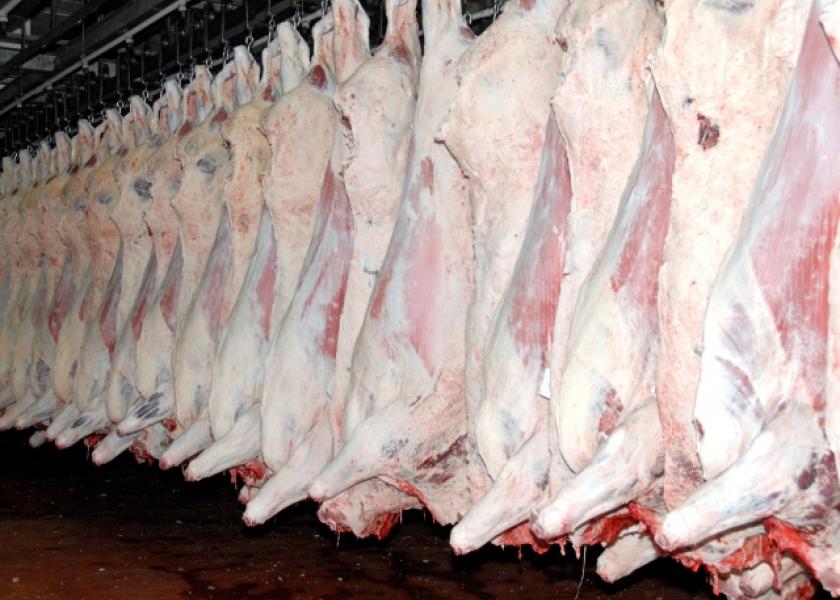How It Works: Instrument Carcass Grading

One interesting detail about value-based pricing is that a relatively new technology called “instrument grading” is making that process more standardized across the country.
By: Justin Rhinehart, University of Tennessee Beef Cattle Extension Specialist
Beef carcass grading is a service that has been provided by the USDA for more than 80 years. Over those many years, they have made tremendous improvements in the speed and accuracy with which the graders assess quality (marbling, color and maturity) and yield estimates (ribeye area, backfat and KPH). Even though human grading has improved, there are still limitations.
According to an article in Beef Magazine by Walt Barnhart, the number of carcasses grading choice in a given plant can vary as much as 15% from week to week with different sets of graders evaluating similar carcasses. Results also vary with shift. Beef cattle producers who market their product on a value-based grid know that some plants and geographical regions return more favorable results than others. In fact, this is a very important factor for many in deciding where to feed their cattle.
Instrument carcass grading simply refers to using electronic equipment, rather than (or in addition to) human graders, to grade carcasses in the processing plant. It has been developed with the goal of improving accuracy at line speed. The first step toward developing instrument carcass grading actually came more than thirty years ago when the Agriculture Marketing Service (then the Food Safety and Quality Service) teamed up with the National Aeronautics and Space Administration (NASA). From this joint effort, two methods were identified that might accomplish the goal of improving carcass grading: 1) Real-time Ultrasound and 2) Video Image Analysis (VIA). Research on using ultrasound technology took priority for many years. More recently, VIA has been identified as a more suitable technology for assessing ribeye area, USDA yield grade and marbling score.
The VIA systems evaluate lean yield percentage by taking data from digital images of the entire side of beef, the 12th rib section or both. The images are analyzed for the amount of fat and lean muscle based on color and interfaces of different textures. Most of the research has shown that the VIA systems are very accurate in determining ribeye area and backfat thickness at the 12th rib section. At first, these systems were not particularly accurate in determining overall fatness of a carcass or the actual amount of intramuscular fat (marbling). After improvement and validation, the USDA approved them for both yield grade indicators and marbling scores. Research continues to develop instrument determination of tenderness.
The economic impact of improving beef carcass grading has been discussed in many venues but little research has addressed the actual affect it will have as implementation becomes more widespread. A group of researchers from Iowa State University used data from more than 38,000 head to evaluate the effect of improving grader accuracy. To simulate the improved accuracy with instrument grading, they simply added another grader to the line and let one grader estimate quality while the other estimated yield grade. This gave both graders more time to focus on the one task. The most outstanding results of the study were the effects on called yield grades. There was a significant decrease in the percentage of called yield grade 4 and 5 and a significant increase in the percentage of called yield grade 1. Essentially, the errors in calling USDA yield grade were shifting the distribution more toward grades 2 and 3.
The authors of this study suggested that the errors in calling yield grade had a significant effect on plant revenue when valuing cattle on a grid system. So much so that purchasing the relatively expensive grading instruments would pay off in a matter of weeks. More important is the suggestion that decreasing grading errors would improve the confidence of producers that supply the cattle. It would also provide producers, who market on a value-based grid, more incentive to genetically improve carcass quality.
Regardless of how cattle are marketed, their ultimate worth lies in the value of their carcass as estimated by yield and quality grades. As instrument grading becomes commonplace in more packing plants and geographical regions, the distribution of yield and quality grades should become more even across the country. With that, value-based marketing should increase and strengthen as the predominant way to trade finished cattle. As this happens, buyers and stocker operators will need to focus more intensely on their source of calves and cow-calf producers should continue to make improvements in genetics and marketing.







